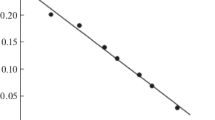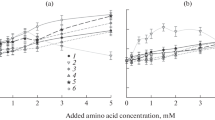Abstract
We investigated the in vitro effects of ions, carbohydrates, lectins, and charged compounds on the cytolytic and hemolytic action of the purified δ-endotoxin ofBacillus thuringiensis var.darmstadiensis 73-E10-2, and other δ-endotoxins. Cytotoxicity was inhibited by preincubating the toxin with N-acetylneuraminic, glucuronic, galacturonic, and N-acetylglutamic acids and ATP. Lectins were unable to inhibit toxicity. Pretreatment of sheep erythrocytes with neuraminidase enhanced hemolysis. These results suggested a nonspecific inhibition of cytotoxicity based on the presence of a negative charge. Supraphysiological concentrations of divalent cations such as Ca2+, Mg2+, and Zn2+ in the medium yielded a reduced toxicity, whereas EDTA and EGTA enhanced cytotoxicity.
Similar content being viewed by others
Literature Cited
Armstrong JL, Rohrman GF, Beaudreau GS (1985) δ-Endotoxin ofBacillus thuringiensis subsp.israelensis. J. Bacteriol 161:39–46
Bashford CL, Alder GM, Patel K, Pasternak CA (1984) Common action of certain viruses, toxins and activated complement: pore formation and its prevention by extracellular calcium. Biosci Rep 4:797–805
Cheung PYK, Roe R, Hammock BD, Judson CL, Montague M (1985) Apparent in vivo neuromuscular effects of the δ-endotoxin ofBacillus thuringiensis var.israelensis in mice and insects of four orders. Pestic Biochem Physiol 23:85–94
Chilcott CN, Kalmakoff J, Pillai JS (1984) Neurotoxic and haemolytic activity of a protein isolated fromBacillus thuringiensis var.israelensis crystals. FEMS Lett 25:259–263
Clague MJ, Cherry RJ (1986). Immobilization of band 3 proteins and inhibition of melittin action by divalent metal ions. Trans Biochem Soc (in press)
Davidson EW, Yamamoto T (1984) Isolation and assay of the toxic component from the crystals ofBacillus thuringiensis var.israelensis. Curr Microbiol 11:171–174
De Barjac H (1978) Une nouvelle variete deBacillus thuringiensis tres toxique pour les moustiques:Bacillus thuringiensis var.israelensis serotype 14. CRS Acad Sci [III] 286:797–800
Drobniewski FA, Ellar DJ (1986) Identification of the principal active mosquitocidal polypeptide ofBacillus thuringiensis var.darmstadiensis strain 73-E10-2. In: Samson RA, Vlak JM, Peters D (eds) Fundamental and applied aspects of invertebrate pathology. Wageningen, The Netherlands: Fourth International Colloquium on Invertebrate Pathology, p 38
Drobniewski FA, Sawyer TJ, Ellar DJ (1986) Mode of action of the the mosquitocidal δ-endotoxin ofBacillus thuringiensis var.darmstadiensis. In: Falmagne P, Alouf JE, Fehrenbach FJ, Thelestam M, Jeljaszewicz J (eds) Bacterial protein toxins. Zentralbl Bakteriol [Naturwissen] Suppl 15, pp 55–56
Ellar DJ, Knowles BH, Haider MZ, Drobniewski FA (1986) Investigation of the specificity, cytotoxic mechanisms and relatedness ofBacillus thuringiensis insecticidal δ-endotoxins from different pathotypes. In: Falmagne P, Alouf JE, Fehrenbach FJ, Thelestam M, Jeljaszewicz J (eds) Bacterial protein toxins. Zentralbl Bakteriol Suppl 15, pp 41–48
Ellar DJ, Thomas WE, Knowles BH, Ward ES, Todd J, Drobniewski FA, Lewis J, Sawyer T, Last D, Nichols C (1985) Biochemistry, genetics and mode of action ofBacillus thuringiensis δ-endotoxins. In: Hoch JA, Setlow P (eds) Molecular biology of microbial differentiation. Washington DC: American Society for Microbiology, pp 230–240
Goldberg LJ, Margalit J (1977) A bacterial spore demonstrating rapid larvicidal activity againstAnopholes sergentii, Uranotaenia unguiculata, Culex univitattus, Aedes aegypti andCulex pipiens. Mosquito News 37:355–358
Handman E, Goding JW (1985) TheLeishmania receptor for macrophages is a lipid-containing glycoconjugate. EMBO J 4:329–336
Heimpel AM, Angus TA (1960) Bacterial insecticides. Bacteriol Rev 24:266–288
Johnson DE (1981) Toxicity ofBacillus thuringiensis entomocidal protein toward cultured insect tissue. J Invertebr Pathol 38:94–101
Knowles BH, Ellar DJ (1986) Characterization and partial purification of a plasma membrane receptor forBacillus thuringiensis var.kurstaki lepidopteran-specific δ-endotoxin. J Cell Sci 83:89–101
Knowles BH, Thomas WE, Ellar DJ (1984) Lectin-like binding ofBacillus thuringiensis var.kurstaki lepidopteran-specific toxin is an initial step in insecticidal action. FEBS Lett 168:197–202
Lowry OH, Rosebrough NJ, Farr AL, Randall RJ (1951) Protein measurements with the Folin phenol reagent. J Biol Chem 193:265–275
Luthy P, Hofmann C, Jaquet F (1985) Inactivation of δ-endotoxin ofBacillus thuringiensis by tannin. FEMS Lett 28:31–33
McLaughlin SG, Szabo G, Eisenman G (1971) Divalent ions and the surface potential of charged phospholipid membranes. J Gen Physiol 58:667–687
Murphy DW, Sohi SS, Fast PG (1976)Bacillus thuringiensis enzyme-digested δ-endotoxin: effect on cultured insect cells. Science 194:954–956
Nishiitsutsuji-Uwo J, Endo Y, Himeno M (1979) Mode of action ofBacillus thuringiensis δ-endotoxin: effect on TN-368 cells. J Invertebr Pathol 34:267–275
Nowak TP, Barondes SH (1975) Agglutinin fromLimulus polyphemus. Biochim Biophys Acta 393:115–123
Padua LE, Ohba M, Aizawa K (1980) Isolates ofBacillus thuringiensis serotype 10 with a highly preferential toxicity to mosquito larvae. J Invertebr Pathol 36:180–186
Somerville HJ (1978) Insect toxin in spores and protein crystals ofBacillus thuringiensis. Trends Biochem Sci 3:108–110
Thomas WE, Ellar DJ (1983)Bacillus thuringiensis var.israelensis crystal δ-endotoxin: effects on insect and mammalian cellsin vivo andin vitro. J Cell Sci 60:181–197
Thomas WE, Ellar DJ (1983) Mechanism of action ofBacillus thuringiensis var.israelensis insecticidal δ-endotoxin. FEBS Lett 154:362–368
Ward ES, Ridley AR, Ellar DJ, Todd JA (1986)Bacillus thuringiensis var.israelensis δ-endotoxin: cloning and expression of the toxin in sporogenic and asporogenic strains ofBacillus subtilis. J Mol Biol 191:13–22
Warren L (1963) Distribution of sialic acids in nature. Comp Biochem Physiol 10:153–171
Wood JL (1972) Composition of midgut contents and haemolymph of the the caterpillarHyalophora cecropia. PhD thesis, Department of Zoology, University of Cambridge, UK
Author information
Authors and Affiliations
Rights and permissions
About this article
Cite this article
Drobniewski, F.A., Knowles, B.H. & Ellar, D.J. Nonspecific ionic effects on the cytolytic and hemolytic properties ofBacillus thuringiensis δ-endotoxins. Current Microbiology 15, 295–299 (1987). https://doi.org/10.1007/BF01589385
Issue Date:
DOI: https://doi.org/10.1007/BF01589385




